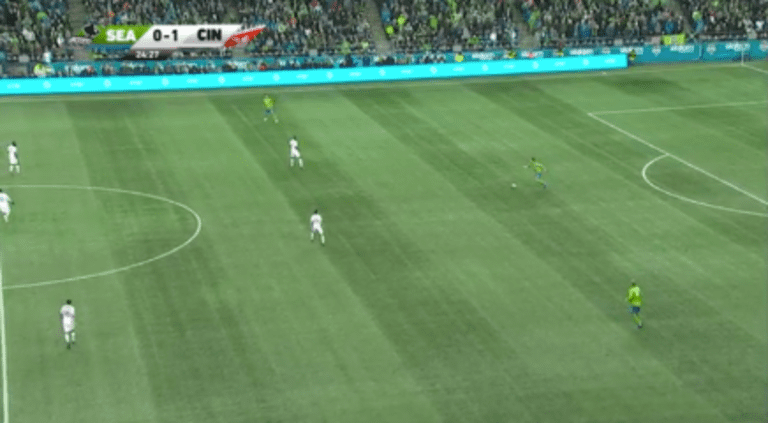Talk about comin’ in hot… What a goal by Leonardo Bertone to go up 1-0 in FC Cincinnati's first-ever MLS game.
Then reality set in pretty quickly. The Seattle Sounders scored three times in the first half, then tacked on one more for good measure to close out a not-fully-encompassing 4-1 win. Welcome to MLS, FC Cincinnati. It won’t get any easier this weekend, either, as they head to Atlanta for Week 2 (Sunday, 5 pm ET | ESPN in US; TSN4 in Canada).
It’s easy to pick on FCC after the Week 1 loss. They looked out of their depth. Here’s the thing to remember, though: A lot of teams look out of their depth in Seattle.
I maintain this notion about FC Cincinnati: They have the roster strength to make the playoffs. Is the roster perfectly constructed? No. Good enough? Yes.
Look at Philadelphia’s roster last year that made the playoffs – was that a more talented XI entering the season than Cincinnati’s? Ditto the Rapids team in 2016 that came within a whisker of winning the Supporters’ Shield. Seattle-level talent helps, but it’s not a prerequisite for making the knockout games.
Philadelphia and Colorado set their teams up to maximize the players and make the whole greater than the sum of the parts. Cincinnati have the foundation to do the same. The next step is doing it.
So what adjustments does Alan Koch need to make in advance of Atlanta on Sunday?
Against Seattle, the expansion side opted for a 4-2-3-1 in attack and a 4-4-2 when out of possession. Both pretty standard. The surprising part… they started with a high line of confrontation. They consistently positioned their forwards about 5-10 yards beyond the top of the center circle, hoping to begin to get pressure on the ball somewhere in that area. It’s an adventurous starting point; not even the proven-elite teams around the league position their forwards that high in Seattle.

FC Cincinnati's high line of confrontation in Seattle.
Pros: You can win the ball higher up the field, as the Red Bulls have demonstrated over the years. But more relevant to FC Cincy, I think, is the statement of intent; you show you aren’t scared of anyone. You’re stepping into the arena with the gladiators and demonstrating you won’t back down to anyone.
Cons: You start from a position of exposure, with increased distance between your lines. Everyone’s asked to cover more ground. If they don’t handle the responsibility, the opponent has more space.
And Seattle had space, which they used to the tune of 663 pass attempts (second most on the weekend) and 64 percent possession.
Cincinnati took a risk and got crushed by it.
Here’s the tricky part in the film breakdown: It wasn’t the initial high line of confrontation that hurt Cincinnati; Seattle didn’t create any scoring opportunities from full buildouts. It was the extension of that overly-aggressive mindset to other scenarios.
- FCC continuously tried to step their lines everywhere to get pressure on the ball.
- They did so before they were ready as a full unit; they started the pressure before they had their ducks in a row, so to speak.
- If you attempt to pressure the ball before your teammates have aligned behind you, the person on the ball makes a simple pass to bypass you.
It happened twice in the lead up to Seattle’s first goal:
Before you get pressure on the ball, you have to make sure they can’t make a pass through the middle of your team. If they will be able to pass through you, then you have to adjust your positioning to block the entry pass before you do anything else. Deny an entry pass, then apply pressure to the ball.
Cincinnati rarely had Seattle blocked in front of them. The Sounders always had FCC chasing from one situation to the next.
That type of pressing can work, but you need athletic and/or energetic players (Tyler Adams, Roger Espinoza, Chad Marshall). Cincinnati doesn’t have those guys.
Specifically, they don’t have the center backs for it. Kendall Waston and Nick Hagglund are excellent in the air and at winning individual duels (same for Forrest Lasso), but they can’t cover space (compared to Tim Parker or Aaron Long, for example). It’s fine to assume risk if you have center backs who can clean up the mess in open space. Cincinnati don’t.
Hagglund and Waston have usable attributes – Waston is a two-time MLS Best XI selection and Hagglund started 13 games for an MLS Cup-winning team – but you need to play to their strengths. Keep the game in front of them; force the opponent to pound crosses into them. Good luck attacking headers in the box through Waston and Hagglund.
Three things to adjust:
- Drop the line of pressure.
- Don’t ask players to step without proper shape behind them, keep the game in front of you.
- The opponent might have time to make a successful pass, but make sure it goes lateral. Hagglund, Waston, and Lasso can deal with crosses all day. Use the elite aerial ability of the center backs to gain control of the game, even if you don’t have control of the ball.
If you’re constantly chasing the ball fruitlessly, you’re chasing the game. And if you’re chasing the game, you can’t implement anything to harm the opponent. FCC have exciting pieces when they get can ahold of the game – give me Darren Mattocks, Kekuta Manneh, and Fanendo Adi running at a back four all day. But they have to get ahold of the game first.
I appreciate Koch’s opening-game approach. He’s clearly instilled a mindset into the team. But FCC need to trade some of that fearless for thoughtfulness.
They aren’t that far from being a playoff team. But only if they get 11 to function as one, and play to the strengths of the players.













